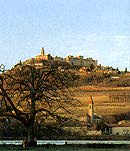Roero Arneis – Noble White Wine
written by David Anderson limited rights reserved ViewItaly.blogspot.com
 Arneis in the dialect from Piemonte mean “a little crazy”. Legend has it that this name was given because the wine was somewhat difficult to produce and the annual production was inconsistent. Arneis has deep roots in Piemonte, in fact locally it is still called “Nebbiolo Bianco” or the white Nebbiolo. This grape was almost wiped out with the arrival of Barbera. It was kept alive because many farmers would plant about 5% of their vineyards, which were Nebbiolo and Barbera, with Arneis. They would use the white grapes for their own table wine and in years where the production was abundant they would cut the Nebbiolo grapes with 2-5% Arneis. This resulted in a smooth red even when very young.
Arneis in the dialect from Piemonte mean “a little crazy”. Legend has it that this name was given because the wine was somewhat difficult to produce and the annual production was inconsistent. Arneis has deep roots in Piemonte, in fact locally it is still called “Nebbiolo Bianco” or the white Nebbiolo. This grape was almost wiped out with the arrival of Barbera. It was kept alive because many farmers would plant about 5% of their vineyards, which were Nebbiolo and Barbera, with Arneis. They would use the white grapes for their own table wine and in years where the production was abundant they would cut the Nebbiolo grapes with 2-5% Arneis. This resulted in a smooth red even when very young.Arneis has its origins in Roero. Today it is produced in this small area outside of Cuneo and in the Langhe. Dating back to the 1600s originally Aneis was a sweet wine and the Savoias, the royal family from Turin, were the primary clients. Arneis grows in a hilly region near Cuneo. Its particular characteristics are due to the sandy ground in the hills and the marine deposits left 12-15 millions years ago.
The landscape has changed little in the last 200 years, rolling hills with bright sun falling into the valleys that lead to Cuneo. This grape is so sweet that the birds would come from all around to consume this grape. What remained was transformed into a sweet wine “for the women”. It is said that it made the women, hardened by the environment, more relaxed and friendly. The sweet wine made from Arneis was held, jealously, until the period of Carnival and was the drink of great celebrations.
 Perhaps it was this quality that saved this vine from extinction until it was finally understood as one of the greatest white wines on the earth today. It is produced as a dry white wine to accent the flavors. Great as an every day before dinner wine and with most fish and white meat, Arneis is a must in every cellar.
Perhaps it was this quality that saved this vine from extinction until it was finally understood as one of the greatest white wines on the earth today. It is produced as a dry white wine to accent the flavors. Great as an every day before dinner wine and with most fish and white meat, Arneis is a must in every cellar.Grape: Arneis
Color: Hay yellow.
Bouquet: delicate and fresh with a hint of wild herbs.
Flavor: Dry, pleasantly bitter of wild herbs.
Alcohol Content: minimum 10.5% however most good years will be 11.5-12.5%.
Serving Temperature: 15-17 degrees centigrade, best chilled to 15 degrees.
Decanting: None.
Pouring: Avoid holding the bottle around the neck. This will increase the temperature of the wine. Some servers will use a napkin or towel and hold the bottle at the bottom to avoid changes in temperature.
Glass: use a clear narrow mouthed, stemmed glass. Pour small amounts at a time. The surface area of the glass will quickly bring the wine to room temperature.
This wine is incredible with appetizers and fish. Dry to the taste and the harmonic bitter of wild herbs compliments fish and white meats.
Tags: Roero Arneis Wine Vacation Agriturismo Food and Wine Italian Wine Piemonte Travel Italy
Labels: Italian Wine, Piemonte, White Wine



0 Comments:
Post a Comment
<< Home